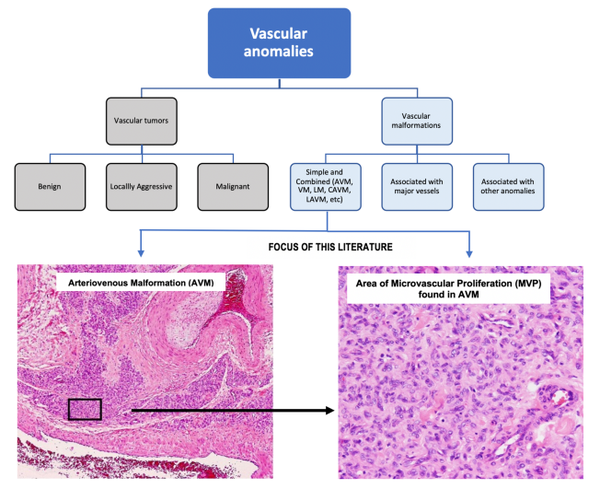-
Home
-
About JCTR
-
Gold Open Access
-
Issues
-
Editorial board
-
Author guidelines
-
Publication fees
-
Online first
-
Special issues
-
News
-
Publication ethics
-
Partners
-
Submit your manuscript
-
Submit your review report
-
Editorial Office
-

This work is licensed under a Creative Commons Attribution-NonCommercial 4.0 International License. ISSN print: 2382-6533 ISSN online: 2424-810X
Volume 7 issue 4
A literature review of microvascular proliferation in arteriovenous malformations of skin and soft tissue
Amalia Mulia Utami#*, Siham Azahaf#, Onno J. de Boer, Chantal M.A.M. van der Horst, Lorine B. Meijer-Jorna, Allard C. van der Wal
Utami et al. J Clin Transl Res 2021; 7(4):11
Published online: July 30, 2021
Abstract
Background and aim: Arteriovenous malformations (AVM) are defined as being quiescent vascular masses composed of mature vessels. However, recent studies reported areas of microvascular proliferation (MVP) in AVM, indicating a process of angiogenesis. As this finding questions the previous definition, the primary objective of this review was to evaluate whether angiogenesis occurs in vascular malformations of skin and soft tissue, and secondly, to identify potential factors involved in MVP.
Method: Due to the multifaceted nature of this subject, a hermeneutic methodology was used to select articles that were likely to provide a deeper understanding of MVP in vascular malformations. Through citation tracking and database searching in PubMed and Web of Science, relevant articles were identified. All study designs concerning occurrence of MVP in AVM of skin and soft tissue in all age groups were included. The Newcastle-Ottawa scale was used for quality assessment.
Results: 16 studies were included in this review which reported occurrence of MVP areas in between the otherwise mature vessels of vascular malformations. In these studies, angiogenesis was reported only in AVM-type of vascular malformations. Increased levels of pro-angiogenic factors were also reported and proliferation was found most prominently during adolescence. Finally, several types of hormone receptors also have been described in tissues of AVM.
Conclusion: Overall, the reviewed data support occurrence of active angiogenesis, highlighted by the presence of MVP in the arteriovenous type of vascular malformations, and a possible concurrent lesion progression towards a higher Schobinger stage of clinical severity. The relative scarcity of data at present implies that further research is required to elucidate the nature of MVP in AVM, which could have implications for developing targeted pharmacotherapy.
Relevance for patients: Active angiogenesis caused by MVP in AVM patients is known to be correlating to clinical symptoms and contributing to the progression of the disease, recurrence rate, and patient’s quality of life.

DOI: http://dx.doi.org/10.18053/jctres.07.202104.011
# Contributed equally
Author affiliation
1. Department of Pathology, Amsterdam University Medical Center, University of Amsterdam, Amsterdam, The Netherlands
2. Department of Pathology Anatomy, Faculty of Medicine, Universitas Hasanuddin, Makassar, Indonesia
3. Amsterdam University Medical Center, Vrije University, Amsterdam, The Netherlands
4. Department of Plastic Surgery, Amsterdam University Medical Center-location AMC, University of Amsterdam, Amsterdam, The Netherlands
5. Symbiant Pathology Expert Center, NWZ- Noordwest Ziekenhuisgroep, Alkmaar, The Netherlands
*Corresponding author
Amalia Mulia Utami
Department of Pathology, Amsterdam University Medical Center, University of Amsterdam, Amsterdam, The Netherlands.
Department of Pathology Anatomy, Faculty of Medicine, Universitas Hasanuddin, Makassar, Indonesia.
Email: amalia.m.utami@gmail.com
Handling editor:
Michal Heger
Department of Pharmaceutics, Utrecht University, the Netherlands
Department of Pharmaceutics, Jiaxing University Medical College, Zhejiang, China

